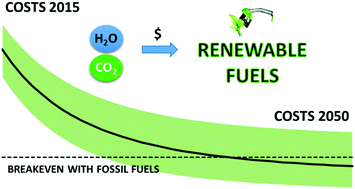当前位置:
X-MOL 学术
›
Energy Environ. Sci.
›
论文详情
Our official English website, www.x-mol.net, welcomes your
feedback! (Note: you will need to create a separate account there.)
The future of solar fuels: when could they become competitive?†
Energy & Environmental Science ( IF 32.4 ) Pub Date : 2018-05-04 00:00:00 , DOI: 10.1039/c8ee00111a R. J. Detz 1, 2, 3, 4, 5 , J. N. H. Reek 3, 4, 5, 6 , B. C. C. van der Zwaan 1, 2, 3, 4, 5
Energy & Environmental Science ( IF 32.4 ) Pub Date : 2018-05-04 00:00:00 , DOI: 10.1039/c8ee00111a R. J. Detz 1, 2, 3, 4, 5 , J. N. H. Reek 3, 4, 5, 6 , B. C. C. van der Zwaan 1, 2, 3, 4, 5
Affiliation

|
Solar energy driven processes with H2O and CO2 as basic feedstocks can produce “solar fuels” that could substitute their fossil based counterparts. This article summarizes the main findings of a techno-economic analysis of systems that can generate different types of fuels with renewable energy as starting point. These “renewable fuels” could potentially play a key role in future energy systems, both as a storage medium in the power sector and as an energy carrier in e.g. the transport sector, or deliver fundamental building blocks for the chemical industry. We determine whether, how, and when renewable fuels might become competitive alternatives for fossil fuels. The technologies required to produce renewable fuels are analyzed by the application of learning curves associated with individual system components. We thereby make projections for possible decreases in investment costs and reductions in fuel production costs. In an optimistic scenario we find that competitivity could be reached between 2025 and 2048 for all renewable energy production pathways that we investigate, for hydrogen, syngas, methanol, and diesel. Two techniques yield break-even costs before 2050 even in a conservative base case scenario: H2 production through electrolysis and diesel production by Fischer–Tropsch synthesis. Both processes use solid oxide electrolysis, which profits from rapid cost reductions and high efficiency.
中文翻译:

太阳能的未来:它们何时才能具有竞争力?†
以H 2 O和CO 2为基本原料的太阳能驱动过程可以产生“太阳能”,可以替代其化石燃料。本文总结了对系统进行技术经济分析的主要发现,这些系统可以生成以可再生能源为起点的不同类型的燃料。这些“可再生燃料”可能在未来的能源系统中扮演重要角色,既可以作为电力部门的存储介质,也可以作为例如运输部门,或为化工行业提供基本的构建基块。我们确定可再生燃料是否,如何以及何时成为化石燃料的竞争性替代品。生产可再生燃料所需的技术通过应用与各个系统组件相关的学习曲线进行分析。因此,我们对可能的投资成本降低和燃料生产成本的降低做出了预测。在乐观的情况下,我们发现我们研究的所有可再生能源生产途径(氢气,合成气,甲醇和柴油)都可以在2025年至2048年之间达到竞争优势。即使在保守的基本情况下,两种技术也会在2050年前产生收支平衡成本:H 2电解生产,费托合成生产柴油。两种工艺都使用固体氧化物电解,这得益于快速降低成本和高效率。
更新日期:2018-05-04
中文翻译:

太阳能的未来:它们何时才能具有竞争力?†
以H 2 O和CO 2为基本原料的太阳能驱动过程可以产生“太阳能”,可以替代其化石燃料。本文总结了对系统进行技术经济分析的主要发现,这些系统可以生成以可再生能源为起点的不同类型的燃料。这些“可再生燃料”可能在未来的能源系统中扮演重要角色,既可以作为电力部门的存储介质,也可以作为例如运输部门,或为化工行业提供基本的构建基块。我们确定可再生燃料是否,如何以及何时成为化石燃料的竞争性替代品。生产可再生燃料所需的技术通过应用与各个系统组件相关的学习曲线进行分析。因此,我们对可能的投资成本降低和燃料生产成本的降低做出了预测。在乐观的情况下,我们发现我们研究的所有可再生能源生产途径(氢气,合成气,甲醇和柴油)都可以在2025年至2048年之间达到竞争优势。即使在保守的基本情况下,两种技术也会在2050年前产生收支平衡成本:H 2电解生产,费托合成生产柴油。两种工艺都使用固体氧化物电解,这得益于快速降低成本和高效率。











































 京公网安备 11010802027423号
京公网安备 11010802027423号